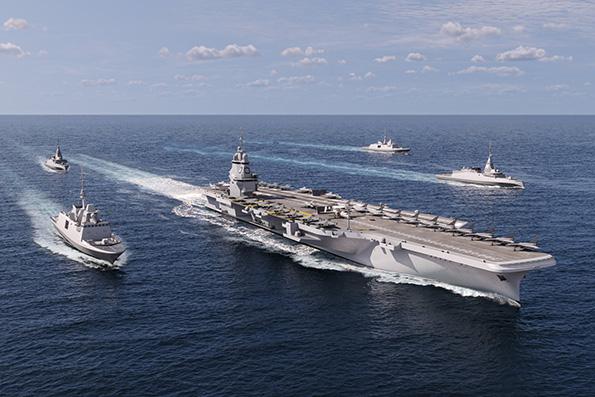Clean-Sheet Review Prompts French Defense Spending Drive

France’s future aircraft carrier program is likely to be a major beneficiary of the defense spending boost.
France’s military is to pivot toward high-intensity warfighting rather than so-called conflicts of choice, President Emmanuel Macron has declared. Prompted by the Russia-Ukraine war and after more than a decade of counterinsurgencies in Africa and the Middle East, Macron wants to “transform” the armed services for what he called “more brutal, more numerous and ambiguous wars.”
At the heart of this effort will be a strengthening of the country’s nuclear deterrent; extensive modernization of the land, sea and air forces; and bolstering of intelligence-gathering and cybercapabilities.
- Combat air fleet could be consolidated around the Rafale
- Ukraine conflict has inspired low-cost, low-tech warfighting
This would be backed up with enlarged reserve forces, enhanced logistics and a surfeit of weapons stocks and support services, Macron told military personnel in a speech at the Mont-de-Marsan air base on Jan. 20.
Priming the effort will be a budgetary increase of more than €100 billion ($109 billion) in 2024-30, with the country’s military programming law (LPM) valued at €413 billion, compared with €295 billion in 2019-24.
The budgetary boosts align with increases across Europe in response to the Russian invasion of Ukraine. The increases will push French defense spending well over NATO’s target of 2% of GDP. NATO’s own spending figures suggest French spending was 1.8-2% of GDP in the last five years.
While earlier LPM increases “repaired” the French Armed Forces, the new funding would allow them to “act more quickly and be more reactive,” Macron said. The military also may be called upon to intervene on short notice, even far from mainland France, he suggested, noting that the country’s numerous overseas territories, particularly those in the Pacific and Indian oceans, are at the “forefront of the possible confrontations of tomorrow,” he said.
The increases were prompted by an ongoing clean-sheet examination of the country’s defense strategies, and work is proceeding at pace within the French defense ministry to prepare the LPM for publication for Bastille Day, July 14.
In the background, military planners are grappling with the sudden increases after decades of budget cuts and drip-feeding of funding to preserve essential capabilities—and they recognize that acquisition will have to be smarter and faster.
France could not afford simply to do “the same with more,” Macron said, warning that defense officials should not fall into the trap of seeking “technological refinement.” The Ukraine conflict confirmed there is a need for balance between “advanced technology and the rudimentary,” he added.
Officials also are reexamining the requirements around new military capabilities, such as whether the Future Combat Air System (FCAS) still will be relevant by the time it enters service in 2040. They also warn that suppliers should expect more pressure on costs and production rates, contending that industry now enjoys advance visibility of national requirements, thanks to the LPM documentation.
France has pointed to some of the investments that could benefit from the additional funding, including a new 75,000-ton, 300-m-long (1,000-ft.) aircraft carrier that is in early development and is slated to carry the naval New-Generation Fighter (NGF) component of the FCAS.
In early January, feasibility studies were contracted to Airbus and Dassault to examine whether the A320neo or Falcon 10X business jet, respectively, could be adapted into maritime patrol aircraft to replace France’s long-serving Atlantique 2 platform.
Switching to a single fleet of Rafale fighters also is under consideration. This would mean retirement of the Mirage 2000 could be accelerated, transitioning France to a single-type combat fleet, at least until the introduction of the NGF. France has traditionally operated at least two or more combat aircraft types, but proponents of the idea say the Rafale’s reportedly lower maintenance costs would make such a move worthwhile.
The LPM is likely to call for the services to acquire loitering munitions as well as for the number of uncrewed aircraft systems (UAS) to be doubled and for air defenses, including those to fight other UAS, to be strengthened by 50%, Macron said. There also would be efforts to boost long-range strike capabilities and restore the air force’s enemy air defense suppression mission, a task due to be added to the Rafale in 2030. Space capabilities would be enhanced, too, with a focus on new space services for surveillance, communication and protection.
The new funding would make France “more solid in defending its sovereignty,” Macron said, adding that he would continue to secure regional partners, strengthening pacts with Germany, Italy, Spain and the UK.






